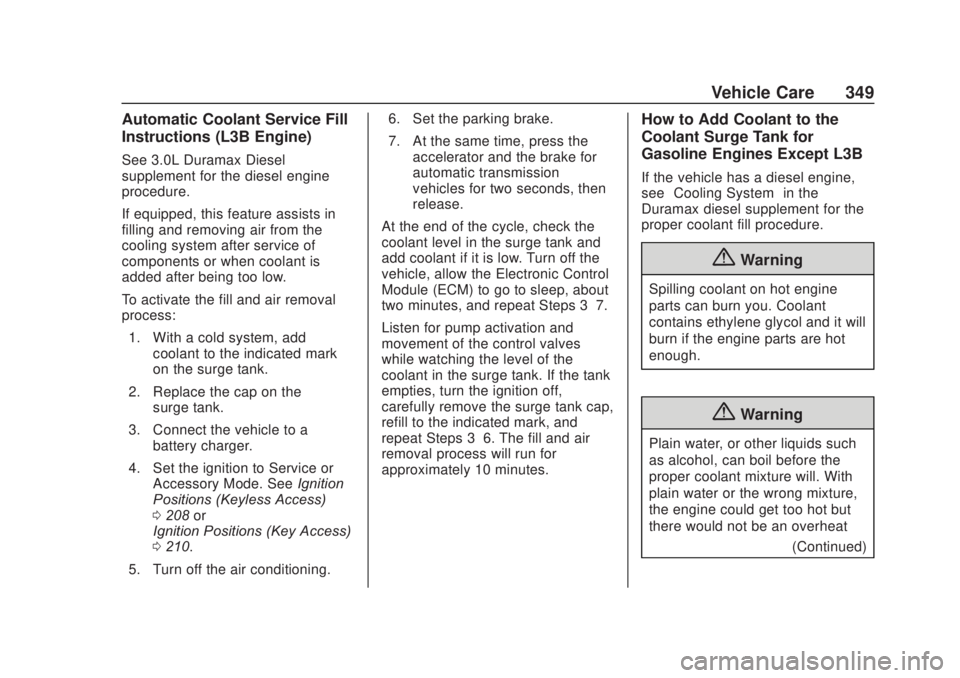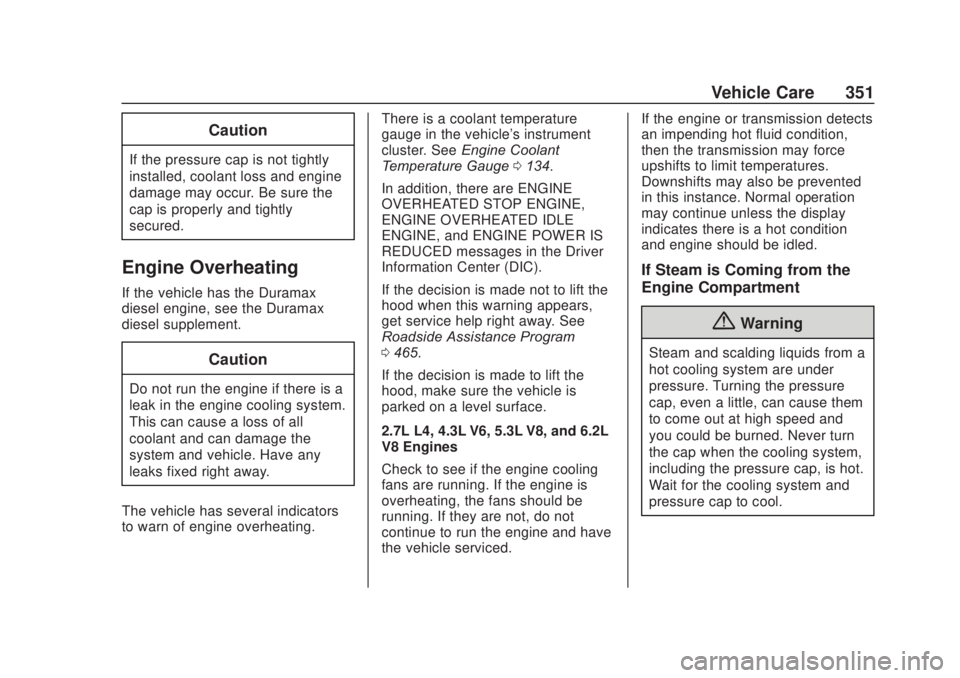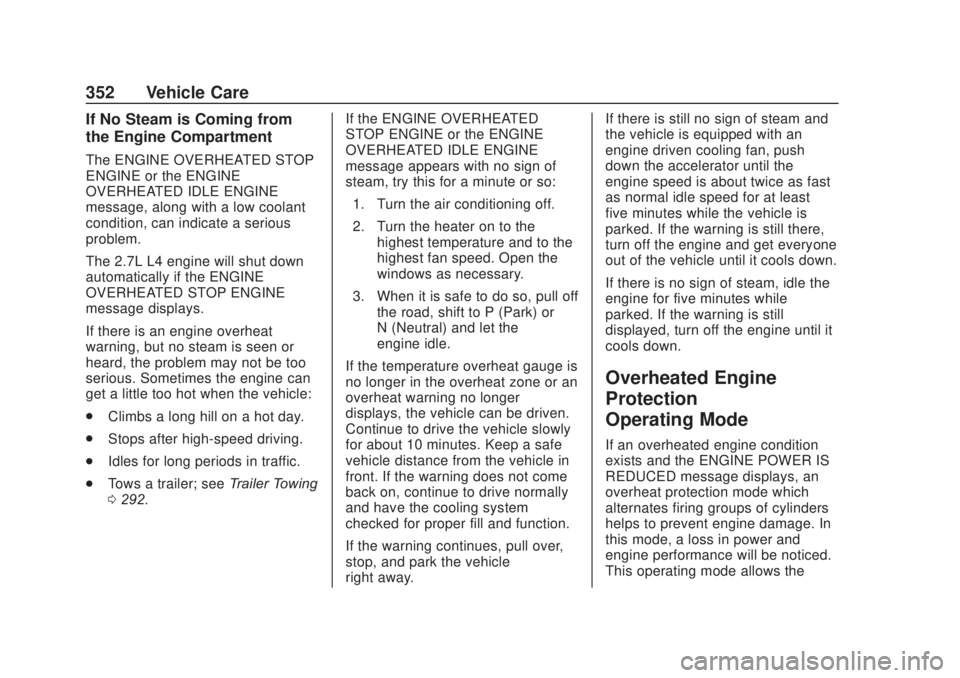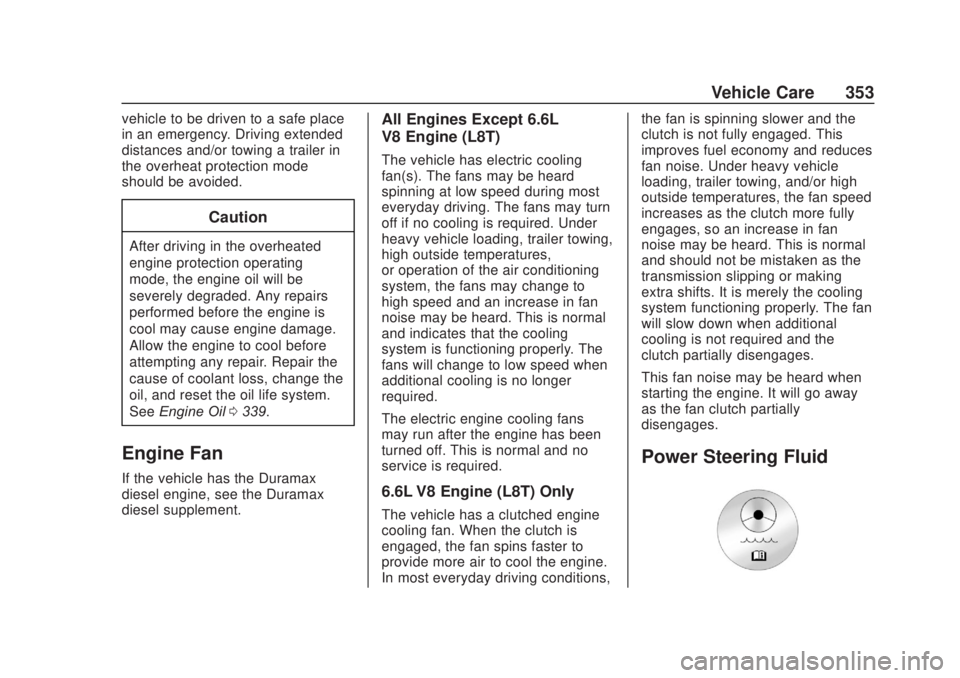2020 CHEVROLET SILVERADO 1500 engine overheat
[x] Cancel search: engine overheatPage 350 of 500

Chevrolet Silverado Owner Manual (GMNA-Localizing-U.S./Canada/Mexico-
13337620) - 2020 - CRC - 4/10/19
Vehicle Care 349
Automatic Coolant Service Fill
Instructions (L3B Engine)
See 3.0L Duramax Diesel
supplement for the diesel engine
procedure.
If equipped, this feature assists in
filling and removing air from the
cooling system after service of
components or when coolant is
added after being too low.
To activate the fill and air removal
process:1. With a cold system, add coolant to the indicated mark
on the surge tank.
2. Replace the cap on the surge tank.
3. Connect the vehicle to a battery charger.
4. Set the ignition to Service or Accessory Mode. See Ignition
Positions (Keyless Access)
0 208 or
Ignition Positions (Key Access)
0 210.
5. Turn off the air conditioning. 6. Set the parking brake.
7. At the same time, press the
accelerator and the brake for
automatic transmission
vehicles for two seconds, then
release.
At the end of the cycle, check the
coolant level in the surge tank and
add coolant if it is low. Turn off the
vehicle, allow the Electronic Control
Module (ECM) to go to sleep, about
two minutes, and repeat Steps 3–7.
Listen for pump activation and
movement of the control valves
while watching the level of the
coolant in the surge tank. If the tank
empties, turn the ignition off,
carefully remove the surge tank cap,
refill to the indicated mark, and
repeat Steps 3–6. The fill and air
removal process will run for
approximately 10 minutes.
How to Add Coolant to the
Coolant Surge Tank for
Gasoline Engines Except L3B
If the vehicle has a diesel engine,
see “Cooling System” in the
Duramax diesel supplement for the
proper coolant fill procedure.
{Warning
Spilling coolant on hot engine
parts can burn you. Coolant
contains ethylene glycol and it will
burn if the engine parts are hot
enough.
{Warning
Plain water, or other liquids such
as alcohol, can boil before the
proper coolant mixture will. With
plain water or the wrong mixture,
the engine could get too hot but
there would not be an overheat
(Continued)
Page 351 of 500

Chevrolet Silverado Owner Manual (GMNA-Localizing-U.S./Canada/Mexico-
13337620) - 2020 - CRC - 4/10/19
350 Vehicle Care
Warning (Continued)
warning. The engine could catch
fire and you or others could be
burned.
{Warning
Steam and scalding liquids from a
hot cooling system are under
pressure. Turning the pressure
cap, even a little, can cause them
to come out at high speed and
you could be burned. Never turn
the cap when the cooling system,
including the pressure cap, is hot.
Wait for the cooling system and
pressure cap to cool.
Caution
Failure to follow the specific
coolant fill procedure could cause
the engine to overheat and could(Continued)
Caution (Continued)
cause system damage. If coolant
is not visible in the surge tank,
contact your dealer.
If no coolant is visible in the surge
tank, add coolant.
1. Remove the coolant surge tank pressure cap when the cooling
system, including the coolant
surge tank pressure cap and
upper radiator hose, is no
longer hot.
Turn the pressure cap slowly
counterclockwise about one full
turn. If a hiss is heard, wait for
that to stop. A hiss means
there is still some pressure left.
2. Keep turning the pressure cap slowly, and remove it. 3. Fill the coolant surge tank with
the proper mixture to the full
cold mark.
4. With the coolant surge tank pressure cap off, start the
engine and let it run until the
engine coolant temperature
gauge indicates approximately
90 °C (195 °F).
By this time, the coolant level
inside the coolant surge tank
may be lower. If the level is
lower, add more of the proper
mixture to the coolant surge
tank until the level reaches the
indicated mark.
5. Replace the pressure cap tightly.
6. Verify coolant level after the engine is shut off and the
coolant is cold. If necessary,
repeat coolant fill procedure
Steps 1–6.
Page 352 of 500

Chevrolet Silverado Owner Manual (GMNA-Localizing-U.S./Canada/Mexico-
13337620) - 2020 - CRC - 4/10/19
Vehicle Care 351
Caution
If the pressure cap is not tightly
installed, coolant loss and engine
damage may occur. Be sure the
cap is properly and tightly
secured.
Engine Overheating
If the vehicle has the Duramax
diesel engine, see the Duramax
diesel supplement.
Caution
Do not run the engine if there is a
leak in the engine cooling system.
This can cause a loss of all
coolant and can damage the
system and vehicle. Have any
leaks fixed right away.
The vehicle has several indicators
to warn of engine overheating. There is a coolant temperature
gauge in the vehicle's instrument
cluster. See
Engine Coolant
Temperature Gauge 0134.
In addition, there are ENGINE
OVERHEATED STOP ENGINE,
ENGINE OVERHEATED IDLE
ENGINE, and ENGINE POWER IS
REDUCED messages in the Driver
Information Center (DIC).
If the decision is made not to lift the
hood when this warning appears,
get service help right away. See
Roadside Assistance Program
0 465.
If the decision is made to lift the
hood, make sure the vehicle is
parked on a level surface.
2.7L L4, 4.3L V6, 5.3L V8, and 6.2L
V8 Engines
Check to see if the engine cooling
fans are running. If the engine is
overheating, the fans should be
running. If they are not, do not
continue to run the engine and have
the vehicle serviced. If the engine or transmission detects
an impending hot fluid condition,
then the transmission may force
upshifts to limit temperatures.
Downshifts may also be prevented
in this instance. Normal operation
may continue unless the display
indicates there is a hot condition
and engine should be idled.
If Steam is Coming from the
Engine Compartment
{Warning
Steam and scalding liquids from a
hot cooling system are under
pressure. Turning the pressure
cap, even a little, can cause them
to come out at high speed and
you could be burned. Never turn
the cap when the cooling system,
including the pressure cap, is hot.
Wait for the cooling system and
pressure cap to cool.
Page 353 of 500

Chevrolet Silverado Owner Manual (GMNA-Localizing-U.S./Canada/Mexico-
13337620) - 2020 - CRC - 4/10/19
352 Vehicle Care
If No Steam is Coming from
the Engine Compartment
The ENGINE OVERHEATED STOP
ENGINE or the ENGINE
OVERHEATED IDLE ENGINE
message, along with a low coolant
condition, can indicate a serious
problem.
The 2.7L L4 engine will shut down
automatically if the ENGINE
OVERHEATED STOP ENGINE
message displays.
If there is an engine overheat
warning, but no steam is seen or
heard, the problem may not be too
serious. Sometimes the engine can
get a little too hot when the vehicle:
.Climbs a long hill on a hot day.
. Stops after high-speed driving.
. Idles for long periods in traffic.
. Tows a trailer; see Trailer Towing
0 292. If the ENGINE OVERHEATED
STOP ENGINE or the ENGINE
OVERHEATED IDLE ENGINE
message appears with no sign of
steam, try this for a minute or so:
1. Turn the air conditioning off.
2. Turn the heater on to the highest temperature and to the
highest fan speed. Open the
windows as necessary.
3. When it is safe to do so, pull off the road, shift to P (Park) or
N (Neutral) and let the
engine idle.
If the temperature overheat gauge is
no longer in the overheat zone or an
overheat warning no longer
displays, the vehicle can be driven.
Continue to drive the vehicle slowly
for about 10 minutes. Keep a safe
vehicle distance from the vehicle in
front. If the warning does not come
back on, continue to drive normally
and have the cooling system
checked for proper fill and function.
If the warning continues, pull over,
stop, and park the vehicle
right away. If there is still no sign of steam and
the vehicle is equipped with an
engine driven cooling fan, push
down the accelerator until the
engine speed is about twice as fast
as normal idle speed for at least
five minutes while the vehicle is
parked. If the warning is still there,
turn off the engine and get everyone
out of the vehicle until it cools down.
If there is no sign of steam, idle the
engine for five minutes while
parked. If the warning is still
displayed, turn off the engine until it
cools down.
Overheated Engine
Protection
Operating Mode
If an overheated engine condition
exists and the ENGINE POWER IS
REDUCED message displays, an
overheat protection mode which
alternates firing groups of cylinders
helps to prevent engine damage. In
this mode, a loss in power and
engine performance will be noticed.
This operating mode allows the
Page 354 of 500

Chevrolet Silverado Owner Manual (GMNA-Localizing-U.S./Canada/Mexico-
13337620) - 2020 - CRC - 4/10/19
Vehicle Care 353
vehicle to be driven to a safe place
in an emergency. Driving extended
distances and/or towing a trailer in
the overheat protection mode
should be avoided.
Caution
After driving in the overheated
engine protection operating
mode, the engine oil will be
severely degraded. Any repairs
performed before the engine is
cool may cause engine damage.
Allow the engine to cool before
attempting any repair. Repair the
cause of coolant loss, change the
oil, and reset the oil life system.
SeeEngine Oil 0339.
Engine Fan
If the vehicle has the Duramax
diesel engine, see the Duramax
diesel supplement.
All Engines Except 6.6L
V8 Engine (L8T)
The vehicle has electric cooling
fan(s). The fans may be heard
spinning at low speed during most
everyday driving. The fans may turn
off if no cooling is required. Under
heavy vehicle loading, trailer towing,
high outside temperatures,
or operation of the air conditioning
system, the fans may change to
high speed and an increase in fan
noise may be heard. This is normal
and indicates that the cooling
system is functioning properly. The
fans will change to low speed when
additional cooling is no longer
required.
The electric engine cooling fans
may run after the engine has been
turned off. This is normal and no
service is required.
6.6L V8 Engine (L8T) Only
The vehicle has a clutched engine
cooling fan. When the clutch is
engaged, the fan spins faster to
provide more air to cool the engine.
In most everyday driving conditions, the fan is spinning slower and the
clutch is not fully engaged. This
improves fuel economy and reduces
fan noise. Under heavy vehicle
loading, trailer towing, and/or high
outside temperatures, the fan speed
increases as the clutch more fully
engages, so an increase in fan
noise may be heard. This is normal
and should not be mistaken as the
transmission slipping or making
extra shifts. It is merely the cooling
system functioning properly. The fan
will slow down when additional
cooling is not required and the
clutch partially disengages.
This fan noise may be heard when
starting the engine. It will go away
as the fan clutch partially
disengages.
Power Steering Fluid
Page 490 of 500

Chevrolet Silverado Owner Manual (GMNA-Localizing-U.S./Canada/Mexico-
13337620) - 2020 - CRC - 4/2/19
Index 489
Defensive Driving . . . . . . . . . . . . . . . 187
Delayed Locking . . . . . . . . . . . . . . . . . 26
DiagnosticsConnected Services . . . . . . . . . . 485
Differential, Limited-Slip . . . . . . . . 243
Distracted Driving . . . . . . . . . . . . . . . 187
Dome Lamps . . . . . . . . . . . . . . . . . . . 173
Door Ajar Light . . . . . . . . . . . . . . . . . . . . . 147
Delayed Locking . . . . . . . . . . . . . . . . 26
Locks . . . . . . . . . . . . . . . . . . . . . . . . . . . 25
Power Locks . . . . . . . . . . . . . . . . . . . . 26
Drive Belt Routing, Engine . . . . . . 460
Driver Assistance Systems . . . . . 256
Driver Information Center (DIC) . . . . . . . . . . . . . 148, 149
Driver Mode Control . . . . . . . . . . . . 238
Driver Mode Control Light . . . . . . 145
Driving Assistance Systems . . . . . . . . . . 268
Better Fuel Economy . . . . . . . . . 186
Characteristics andTowing Tips . . . . . . . . . . . . . . . . . 287
Defensive . . . . . . . . . . . . . . . . . . . . . 187
Drunk . . . . . . . . . . . . . . . . . . . . . . . . . 188
Hill and Mountain Roads . . . . . . 197
If the Vehicle is Stuck . . . . . . . . . 199
Loss of Control . . . . . . . . . . . . . . . 190 Driving (cont'd)
Off-Road . . . . . . . . . . . . . . . . . . . . . 191
Off-Road Recovery . . . . . . . . . . . 190
Vehicle Load Limits . . . . . . . . . . . 200
Wet Roads . . . . . . . . . . . . . . . . . . . 196
Winter . . . . . . . . . . . . . . . . . . . . . . . . 197
Dual Automatic Climate Control System . . . . . . . . . . . . . . . . 179
E
E85 or FlexFuel . . . . . . . . . . . . . . . . 282
Electric Brake Boost . . . . . . . . . . . . 232
Electric Parking Brake . . . . . . . . . . 233
Electric Parking Brake Light . . . . 140
Electrical Equipment,Add-On . . . . . . . . . . . . . . . . . . . . . . . 322
Electrical System Engine Compartment FuseBlock . . . . . . . . . . . . . . . . . . . . . . . . 371
Fuses and Circuit Breakers . . . 370
Instrument Panel Fuse Block . . . . . . . . . . . . . . . . . . . 374, 376
Overload . . . . . . . . . . . . . . . . . . . . . 370
Electronic Stability Control
(ESC) Off Light . . . . . . . . . . . . . . . . 144
Emergency OnStar . . . . . . . . . . . . . . . . . . . . . . . 476 Engine
Air Cleaner/Filter . . . . . . . . . . . . . 344
Check Light (Malfunction
Indicator) . . . . . . . . . . . . . . . . . . . . 138
Compartment Overview . . . . . . . 332
Coolant Temperature Gauge . . . . . . . . . . . . . . . . . . . . . . 134
Coolant Temperature Warning Light . . . . . . . . . . . . . . . 144
Cooling System . . . . . . . . . . . . . . . 346
Drive Belt Routing . . . . . . . . . . . . 460
Exhaust . . . . . . . . . . . . . . . . . . . . . . 220
Fan . . . . . . . . . . . . . . . . . . . . . . . . . . . 353
Heater . . . . . . . . . . . . . . . . . . . . . . . . 215
Oil Life System . . . . . . . . . . . . . . . 341
Oil Pressure Gauge . . . . . . . . . . 133
Oil Pressure Light . . . . . . . . . . . . 146
Overheated Protection Operating Mode . . . . . . . . . . . . . 352
Overheating . . . . . . . . . . . . . . . . . . 351
Power Messages . . . . . . . . . . . . . 156
Running While Parked . . . . . . . . 220
Starting . . . . . . . . . . . . . . . . . . . . . . . 212
Engine Air Filter Life System . . . . 343
Entry Lighting . . . . . . . . . . . . . . . . . . . 174
Equipment, Towing . . . . . . . . . . . . . 297
Event Data Recorders . . . . . . . . . . 473
Exit Lighting . . . . . . . . . . . . . . . . . . . . 174
Page 494 of 500

Chevrolet Silverado Owner Manual (GMNA-Localizing-U.S./Canada/Mexico-
13337620) - 2020 - CRC - 4/2/19
Index 493
M
MaintenanceRecords . . . . . . . . . . . . . . . . . . . . . . 455
Maintenance and Care Additional . . . . . . . . . . . . . . . . . . . . . 448
Maintenance Schedule . . . . . . . . . 441 Recommended Fluids andLubricants . . . . . . . . . . . . . . . . . . . 451
Transfer Case . . . . . . . . . . . . . . . . 227
Malfunction Indicator Lamp . . . . . 138
Manual Mirrors . . . . . . . . . . . . . . . . . . 41
Manual Mode . . . . . . . . . . . . . . . . . . . 224
Manual Windows . . . . . . . . . . . . . . . . 49
Memory Seats . . . . . . . . . . . . . . . . . . . 59
Messages
Engine Power . . . . . . . . . . . . . . . . 156
Vehicle . . . . . . . . . . . . . . . . . . . . . . . 155
Vehicle Speed . . . . . . . . . . . . . . . . 156
Mirror
Rear Camera . . . . . . . . . . . . . . . . . . . 46
Mirrors Automatic Dimming . . . . . . . . . . . . . 44
Automatic DimmingRearview . . . . . . . . . . . . . . . . . . . . . . 46
Blind Spot . . . . . . . . . . . . . . . . . . . . . . 44
Convex . . . . . . . . . . . . . . . . . . . . . . . . . 40
Folding . . . . . . . . . . . . . . . . . . . . . . . . . 43
Heated . . . . . . . . . . . . . . . . . . . . . . . . . 44 Mirrors (cont'd)
Manual . . . . . . . . . . . . . . . . . . . . . . . . . 41
Manual Rearview . . . . . . . . . . . . . . . 46
Power . . . . . . . . . . . . . . . . . . . . . . . . . . 43
Tilt in Reverse . . . . . . . . . . . . . . . . . . 45
Trailer Tow . . . . . . . . . . . . . . . . . . . . . . 41
Mirrors, Interior Rearview . . . . . . . . 46
Mode . . . . . . . . . . . . . . . . . . . . . . . . . . . 238 Driver Control . . . . . . . . . . . . . . . . . 238
Monitor System, Tire Pressure . . . . . . . . . . . . . . . . . . . . . . 389
N
NavigationConnected Services . . . . . . . . . . 483
New Vehicle Break-In . . . . . . . . . . . 208
Noise Control System . . . . . . . . . . 361
O
Odometer . . . . . . . . . . . . . . . . . . . . . . . 131 Trip . . . . . . . . . . . . . . . . . . . . . . . . . . . 131
Off-Road . . . . . . . . . . . . . . . . . . . . . . . 191 Driving . . . . . . . . . . . . . . . . . . . . . . . . 191
Recovery . . . . . . . . . . . . . . . . . . . . . 190
Oil Engine . . . . . . . . . . . . . . . . . . . . . . . . 339
Engine Oil Life System . . . . . . . 341
Engine Oil Pressure Gauge . . . 133 Oil (cont'd)
Pressure Light . . . . . . . . . . . . . . . . 146
Older Children, Restraints . . . . . . . 85
Online Owner Center . . . . . . . . . . . 464
OnStar . . . . . . . . . . . . . . . . . . . . . . . . . 474
OnStar Additional Information . . . . . . . . . . . . . . . . . . . . 477
OnStar Emergency . . . . . . . . . . . . . 476
OnStar Overview . . . . . . . . . . . . . . . 475
OnStar Security . . . . . . . . . . . . . . . . 477
Operating Mode Overheated EngineProtection . . . . . . . . . . . . . . . . . . . 352
Operation
Fog Lamps . . . . . . . . . . . . . . . . . . . 170
Outlets Power . . . . . . . . . . . . . . . . . . . . . . . . 122
Overheated Engine
Protection Operating Mode . . . . 352
Overheating, Engine . . . . . . . . . . . . 351
Overview Instrument Panel . . . . . . . . . . . . . . . . 5
P
ParkShifting Out of . . . . . . . . . . . . . . . . 218
Park Assist . . . . . . . . . . . . . . . . . . . . . 257